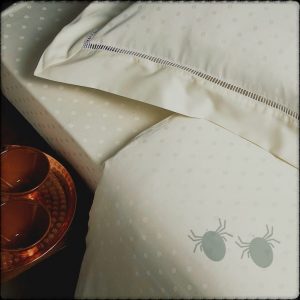PAIN IN THE BED
 The Camino to Santiago might be a spiritual journey, but it’s not exempt from common earthly troubles like bed bugs. Who would have thought that such little creatures could be such a huge pain in the neck? In the past decade, bed bugs have infested some albergues along the Camino causing trouble not only to pilgrims but also hospitaleros.
The Camino to Santiago might be a spiritual journey, but it’s not exempt from common earthly troubles like bed bugs. Who would have thought that such little creatures could be such a huge pain in the neck? In the past decade, bed bugs have infested some albergues along the Camino causing trouble not only to pilgrims but also hospitaleros.
Although inconvenient, the problem is being handled and should not be a reason to give this one-of-a-kind journey. In fact, bed bugs are not exclusive to the Camino or the cheap albergues. You can equally come across them in a five-star hotel. Their widespread reign was not brought about by uncleanliness as much as by the massive increase in international travel.
While it’s a problem, it’s also very likely you will walk the entire way without making this unpleasant acquaintance. Many pilgrims experience a bedbug-free pilgrimage. And if there is an outbreak in an albergue, be 10 or 200 km away, you will know about it (you would be surprised how fast rumors travel on the road).
Before You Go
There are a few things you can do to prevent bedbug infestation before you leave for the Camino.
You can buy sleeping bags, backpacks or sheets that have been pre-treated against bed bugs.
Get silk liners as bedbugs find it difficult to get through silk.
Spray your equipment against bedbugs yourself using permethrin-based products. However be careful and make sure to follow the instructions as the product might be toxic to pets.
Arm yourself with a small torch so you can check the beds thoroughly, and if you know, you are sensitive to insect bites, in general, consult your GP and take along some medicine. Otherwise, you can buy general treatment in pharmacies along the road.
On the Camino
When you get to an albergue, don’t put your backpack on the bed just yet.
Take out your torch and make sure to check everything above and beyond the bed. Examine the bunk frame, mattress as well as pillows (if available). Focus on cracks, mattress seams and bed joints in particular because, as mentioned already, they like dark spaces.
If you do find anything inform the hospitalero immediately, pack your stuff and shuffle on to find new accommodation. You might be offered another room, but I wouldn’t take the risk. If one room is infected, it’s likely the other are too although it might not yet be visible.
If you are slightly paranoid and need to take it a bit further, don’t put your backpack on, under or against the bed no matter where you are. Keep it closed when you aren’t packing or unpacking and seal it in a plastic bag overnight.
Keep yourself covered, as the bugs go after exposed skin. Hence most bites are on the arms, feet or neck.
Before packing and walking on, thoroughly shake out the sleeping bag.
If You Find a Bite.
No matter how tempting it is, try not to scratch the bites and seek out the closest pharmacy to buy the necessary treatment. If you feel queasy or have a violent skin reaction, pay a visit to a local hospital.
Inform the hospitalero immediately. However, if you don’t notice the bites until you are on the road, tell the hospitalero in the next albergue, so they can call and inform them for you.
Whether you have a single bite or hundred, assume the whole “operation” has been compromised. Before you settle in the next hostel, you need to debug your belongings.
Debugging on the Road
Method 1: Lay out all your possessions on the ground (outside) and spray with Permethrin or other bug insecticide known to be effective against bed bugs. Allow the items to dry in the sun Next, wash them by hand or a washing machine with hot water and dry in a hot dryer. If you are in a bigger town and have the finances, take everything including your clothes, sleeping bag and backpack to the dry cleaners.
Method 2: If it’s summer, take everything out of your backpack and turn all the pockets inside out. Put everything into a black garbage bag (pack loosely) Close it tightly. Leave it boiling in the sun for several hours. Then, if possible wash everything in hot water and dry in a dryer.
After the process is done thoroughly examine all the seams and pockets of all your items.If you fail to act quickly, you risk spreading the bedbugs to other albergues and even to your home after your return.
Bedbugs have been a problem on the Camino but definitely not a reason to give up the pilgrimage altogether. It’s probable you will not come across any infected albergues. Plus, if you follow advice and check beforehand, you will be able to avoid impending disaster and find another place to sleep.
Keep safe, be smart and don’t let the bedbugs bite!
www.hostalgautxori.com By Caminoadventures. Image: Pixabay



